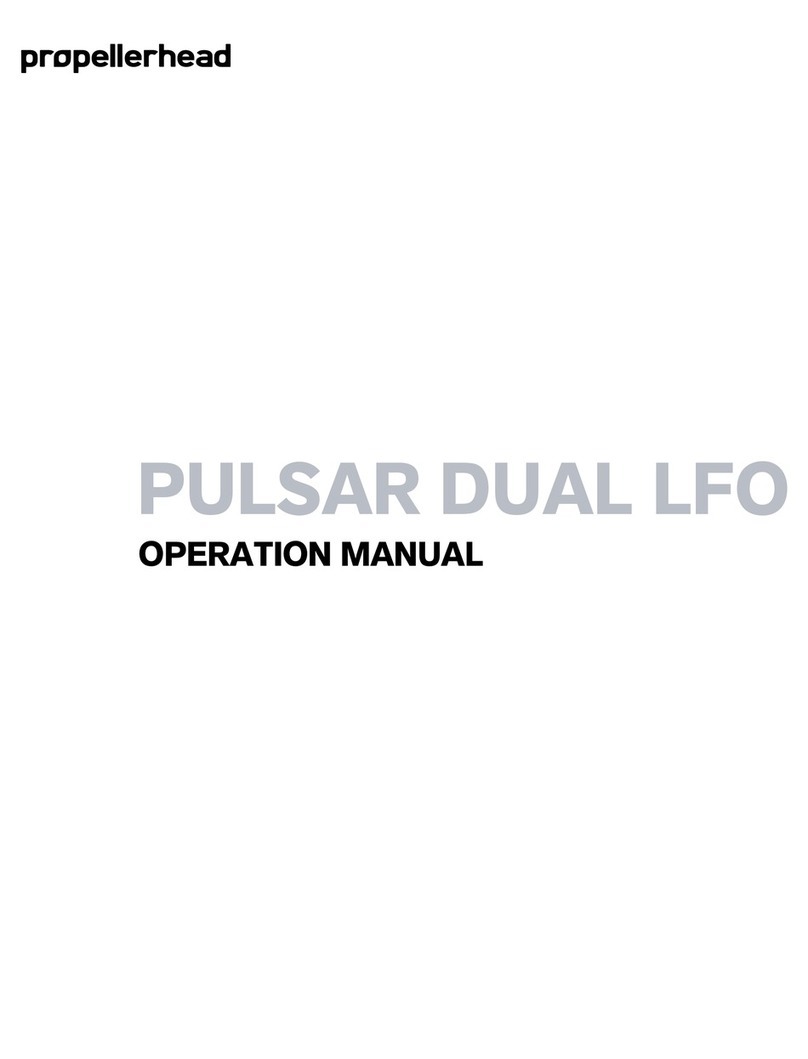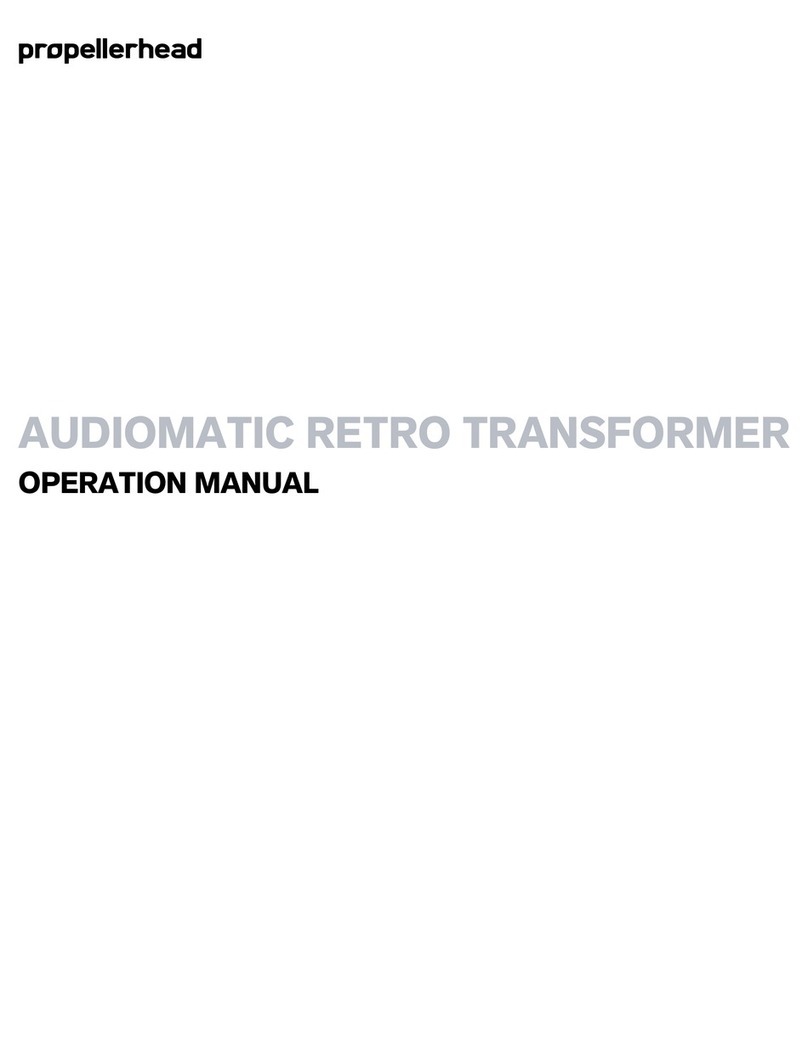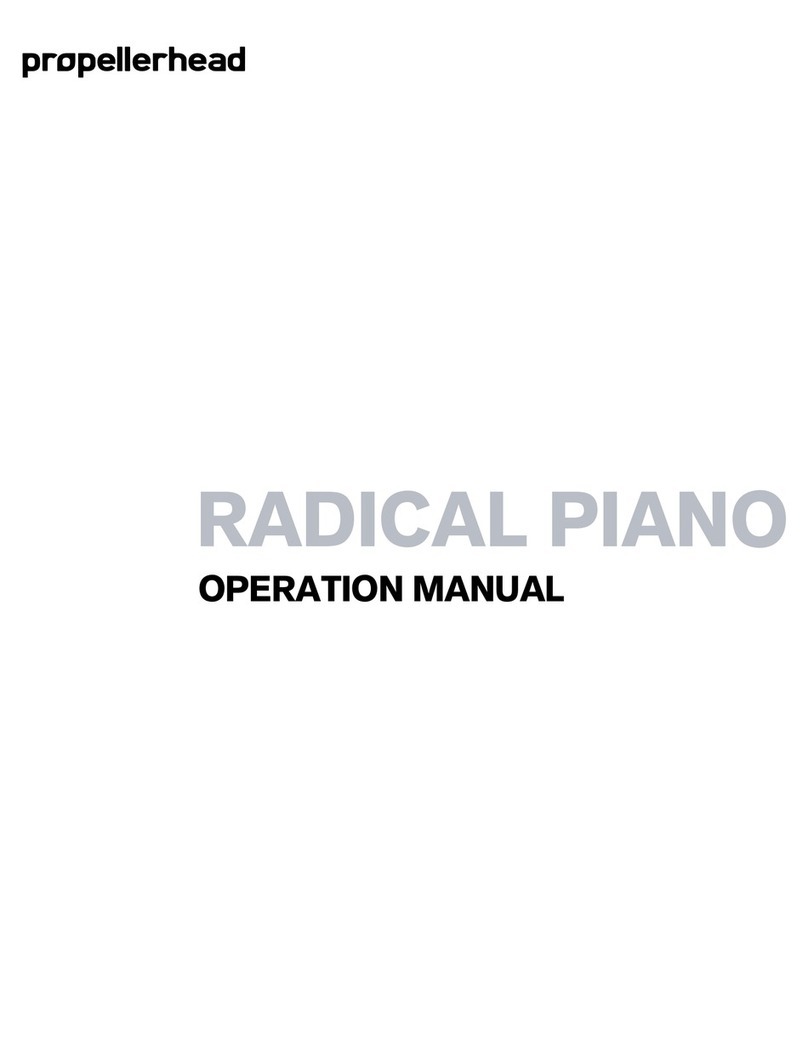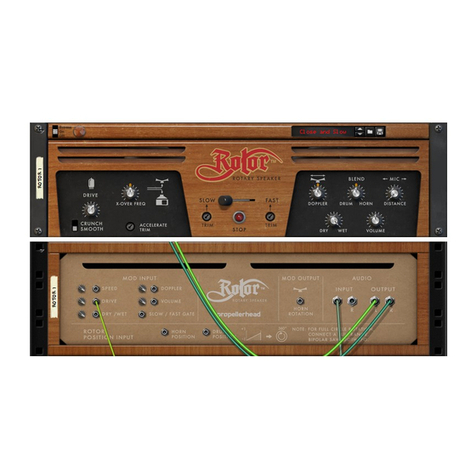Propellerhead Radical Keys User manual

RADICAL KEYS
OPERATION MANUAL

The information in this document is subject to change without notice and does not represent a commitment on the
part of Propellerhead Software AB. The software described herein is subject to a License Agreement and may not be
copied to any other media expect as specifically allowed in the License Agreement. No part of this publication may be
copied, reproduced or otherwise transmitted or recorded, for any purpose, without prior written permission by
Propellerhead Software AB.
©2012 Propellerhead Software and its licensors. All specifications subject to change without notice. Reason,
Reason Essentials and Rack Extension are trademarks of Propellerhead Software. All other commercial symbols
are protected trademarks and trade names of their respective holders. All rights reserved.
All product names used are trademarks of their respective owners, and in no way constitute an association or
affiliation with Propellerhead Software. All trademarks are solely used to identify the products whose sound was
sampled and studied during the development of Radical Keys.

Radical Keys

RADICAL KEYS
4
Introduction
Radical Keys is the second Propellerhead Rack Extension in the “Radical” series. It is designed to be a
straightforward, awesome sounding and totally flexible electric piano which can reach far beyond the traditional sonic
limits of electric pianos.
Radical Keys combines sample playback technology with physical modelling to give you great sound quality and
seamless dynamic response as well as great freedom to tweak your sounds in any directions.
Radical Keys also features sympathetic resonance, which means that any undamped tines or reeds will ring along
with the currently played notes (tines/reeds). This effect, which is derived from the Radical Piano Rack Extension, is
not very prominent (or even audible) in the original electric piano instruments. However, since the effect brings
completely new dimensions to the sound, we thought it would be nice to include this feature also in Radical Keys.
There are also a number of other controls for further shaping the sound the way you want it.
The electric pianos
Radical Keys holds complete sound sets recorded from these three classic electric pianos:
• Rhodes
This is a Rhodes Mk I SeventyThree. The Rhodes uses steel tines in combination with electromagnetic pickups to
generate its sound. The tines and pickups can be mechanically adjusted to achieve different sound character. This
particular Rhodes was adjusted to the “old school” sound with that nice “barking” effect when played at high
velocities. The Rhodes sound usually blend in very well with the other instruments in the mix.
•Wurlitzer
The famous Wurlitzer 200A has a brighter and more “hollow” sound than the Rhodes, especially when played at
high velocities. This makes the Wurly often stand out nicely in the mix. The Wurlitzer uses steel reeds together with
electrostatic pickups to generate its sound.
•Pianet
This is a Hohner Pianet T. The Pianet T uses steel reeds in combination with electro-magnetic pickups. Instead of
hitting the reeds, the reeds are activated by sticky silicon rubber activation pads that are pulled from the reeds,
causing them to vibrate. The same activation pads then work as dampers when the keys are released. The Pianet
T does not feature any active electronics so the output signal has to be amplified, for example, by a guitar amplifier.

RADICAL KEYS 5
Key ranges
The key range in Radical Keys is E0 to E6 (73 notes) for all sounds. However, since the key ranges of the original
Wurlitzer and Pianiet T are more restricted, we have pitched/modelled the notes that exceed the original ranges. The
figure below shows the key ranges of the original instruments (in black) - plus the pitched/modelled notes that we
have added (in red):
The key ranges of the original electric pianos (in black), with the added notes (in red)
C1E0 C2 C3 C4 C5 C6 E6
C1A0 C2 C3 C4 C5 C6
C6
C1F0 C2 C3 C4 C5 E5
Rhodes
Wurlitzer
Pianet

RADICAL KEYS
6
The line and microphone configurations
The electric pianos were recorded from their direct outputs as well as routed via a Musicman RD112-50 combo
amplifier using two microphone configurations: Amp and Room. The different recordings were then stored in Radical
Keys as separate sound sets.
The following configurations were used:
•Line
This signal is taken straight from the built-in outputs of the electric pianos. This clean signal is best suited for
further processing in Radical Keys and/or in external effects devices. You could also combine the line signal with
the Amp or Room signals to achieve great results.
•Amp
A single Neumann U47 tube microphone, or an RCA MI-6203 ribbon microphone, placed in front of the speaker
cabinet of the combo amplifier. This configuration produces a distinct colored sound with nice character.
•Room
Two Sennheiser MKE 212 omnidirectional boundary microphones that lay flat on the floor some distance away
from the amplifier. They add room ambience and richness to the sound and are best used as complement to the
Line or Amp configurations described above.

RADICAL KEYS 7
Using Radical Keys
Loading and saving patches
Loading and saving patches is done in the same way as with any other internal Reason/Reason Essentials device -
see the “Sounds and Patches” chapter in the Reason/Reason Essentials Operation Manual pdf for details.
Selecting piano sound sets
A patch in Radical Keys can consist of a mix between two piano sound sets. The mix could be between two sound
sets from the same piano, or from different pianos. You could, for example, blend a Line’d Rhodes with the Room
microphones from the Wurlitzer to create your own custom piano sound.
The piano sound sets are selected in the Piano Select section:
The Piano Select section.
1. Select desired piano sound set(s) by clicking the corresponding LED button(s).
You can select one sound set to the left of the Instrument Blend knob and one to the right.
2. Set the mix between the sound sets with the Instrument Blend knob.
If you only want to use a single sound set for your sound, set the Instrument Blend knob to min or max.
Character
DSet the character of the sound with the Character knob.
Range: Subdued to Agitated, in 36 steps, with natural sound at the 12 o’clock position.
Subdued produces a warm and mellow tone whereas Agitated generates a brighter and significantly more
pronounced tone.
!Changing the Character value temporarily mutes the audio outputs.

RADICAL KEYS
8
Volume
The master volume control for Radical Keys.
Velocity Response
Most sample-based electric piano instruments and sound libraries on the market use a predefined number of velocity
layers. Depending on how soft or hard you play the keys, samples from a specific velocity layer play back. Due to
memory limitations, the number of velocity layers aren’t often that many. This can make the velocity response feel and
sound unnatural. Thanks to the combination of samples and physical modelling in Radical Keys, all sound sets feature
very wide and completely seamless velocity ranges.
With the Velocity Response knobs you can tailor the dynamic response of your piano sound.
• With the Low knob you set the timbre for the lowest velocity.
With the Low knob set to zero (marked with an ‘S’) playing really soft won’t play back any sound at all. This can be
useful if you, for example, want to hold down a chord and then play other keys to introduce the sympathetic
resonance effect, see “Resonance”.
!Note that this “silence” effect is impossible to achieve on the original Pianet T - no matter how soft you play.
This is because of the way the sound generating mechanism works in the Pianet.
• With the Curve knob you set the shape of the velocity curve - from exponential, via linear to logarithmic.
Set this parameter where it feels the best to play. There is no “perfect” position since most MIDI keyboards
respond differently to velocity.
qIf you want a natural dynamic range, set the Low knob to around the 9 o’clock position and the High knob to
around the 12 o’clock position. Adjust the Curve setting to your liking.
qIf you want a dynamic range that stretches beyond the range of an electric piano, set the Low knob to zero and
the High knob past the 12 o’clock position.
qIf you want a static response (with the same timbre no matter how soft or hard you play), set the Low knob to
max and the High knob to zero. Note that there will still be some velocity sensitivity left for controlling the
volume.
• With the High knob you set the timbre for the highest velocity.
Note that the High parameter can go far beyond the natural range of an electric piano, which is great for
experimental sounds.

RADICAL KEYS 9
Tune
Cent
DSet the overall master tune of your sound with the Cent knob.
Range: +/-1 semitone (+/-100 cents).
Drift
The Drift parameter can be used for introducing a slow irregular pitch variation to your sound. It’s perfect for adding
kind of a melancholic touch to your piano sound.
Resonance
Sympathetic resonance is a physical phenomenon that can occur in acoustic instruments, like in pianos for example.
It means that any undamped strings will ring along with the played strings. For example, if you play a key with the
sustain pedal down, all other strings in the piano will also vibrate at various intensities. Similarly, if you hold down a
number of keys (so that the dampers are off the strings) and then play additional keys, the strings for the held keys
will resonate.
Sympathetic resonance can also occur in electric pianos, but is often not so prominent. However, since the effect
adds a very unique character to the sound, we chose to include also it in Radical Keys.
With the Resonance controls you set the amount of sympathetic resonance in your electric piano sound.
Level
DSet the amount of overall sympathetic resonance in your sound.
Release Time
DSet the time it should take for the sympathetic resonance to fade to silence.
Envelope
Radical Keys features a special type of envelope generator which is used for shaping the character of the electric
piano sound.

RADICAL KEYS
10
Attack
DSet the attack time for the piano sound, from immediate to (unnaturally) slow.
The range is 0-200 ms.
Decay Curve
DSet the shape of the decay curve.
This control determines how the sound should decay when you play and hold the keys.
The range is from exponential, via linear, to logarithmic. Exponential settings will make the sound decay faster and
Logarithmic settings make the sound decay more slowly.
Release
DSet the time it should take for the sound to fade to silence once you release the keys.
This simulates the behavior of the dampers (or rubber activation pads in the Pianet). For example, worn out
dampers could result in somewhat longer release times.
Mechanics
The Mechanics section features controls for the mechanical noise.
Key Down
• Key Down controls the level - and character - of the noise that occurs when the keys are pressed/hit.
At the 12 o’clock position the noise is the most natural. Above the 12 o’clock position the noise is more
pronounced and below the 12 o’clock position the noise is suppressed.
Key Up
• Key Up controls the level of the noise that occurs when the keys are released and the hammers and dampers
(or rubber activation pads in the Pianet) return to their initial positions.
At the 12 o’clock position the noise level is natural. Above the 12 o’clock position the noise is louder and below the
12 o’clock position the noise is quieter.
Pedal
• Pedal controls the level of the noise that occurs when you press and release the sustain pedal.
At the 12 o’clock position the noise level is natural. Above the 12 o’clock position the noise is louder and below the
12 o’clock position the noise is quieter.
!Note that Radical Keys supports continuous sustain pedal functionality which might affect the Pedal noise, see
“Sustain Pedal”.
!Note that the original Pianet T does not feature any sustain pedal. The only way to achieve sustaining notes in
the original instrument is to hold down the desired keys. However, the Pianet sound in Radical Keys can be
controlled from a connected Sustain Pedal, and therefore also feature a faked mechanics noise.

RADICAL KEYS 11
About mono and stereo effects
Some of the effects described in the following paragraphs can be set to work in mono or stereo. When set to mono,
the left and right channels of the signal are treated in “dual mono” mode, i.e. both channels are treated identically -
but separately. When set to stereo, the left and right channels are treated phase inverted compared to each other.
If you use one effect in stereo and the subsequent effect in mono, the stereo effect of the precedent effect will be
preserved.
Tremolo
Tremolo is a type of periodic volume modulation which is very popular to use with electric pianos. The effect can be
used for generating a “pulsating” volume.
The Tremolo effect can be switched on/off by clicking the LED button at the upper left corner.
Speed
DSet the Tremolo speed with the Speed knob.
The red mark at the 12 o’clock position indicates the fixed rate of the original Vibrato effect in the Wurlitzer.
The Speed can be synced to the sequencer tempo by clicking the Sync switch to the right.
Range: 1.36-23.8Hz (synced 32/4-1/64)
Depth
DSet the Tremolo depth (amount) with the Depth knob.
Waveform switch
DSelect one of two different tremolo waveforms with the waveform switch.
The sinewave represents the character of the Vibrato effect in Wurlitzer, whereas the rounded squarewave
represents the character of the Rhodes tremolo effect.
Stereo Width
The Stereo Width control can be used for creating a stereo tremolo effect. Stereo tremolo is typical for Rhodes
suitcase pianos.

RADICAL KEYS
12
Comp
The Compressor can be used to even out the dynamics in the sound.
Comp
DTurn the Comp knob to control the compression amount of your piano sound.
Fast
DClick the Fast switch for a faster compression attack.
This can be useful for reducing transients in the attacks of the sound.
The Compression effect can be switched on/off by clicking the LED button at the top.
Overdrive
The Overdrive effect can be used for adding harmonic distortion to your sound. There are three different distortion
types to choose from:
•Crunch
This is a powerful dynamic type of distortion.
•Crisp
This is a type of soft clipping dynamic overdrive. The louder you play, the more distortion.
•Frost
This is a type of static “distortion pedal” overdrive, with a similar character regardless of volume.
Drive
DSet the overdrive amount with the Drive knob.
Presence
DSet the Presence amount with the Presence knob.
The Presence effect is routed before the Overdrive effect in the signal chain and adds more high mid and treble
to the sound.
The Overdrive effect can be switched on/off by clicking the LED button at the top.

RADICAL KEYS 13
Equalizer
The built-in equalizer is a powerful 3-band EQ with gain controls for the Low, Mid and High bands. The EQ
characteristics have been fine tuned and optimized for electric piano sounds. The gain range is +/-18dB for each of
the bands, which makes it easy to quickly achieve great sonic results.
Pre Overdrive
DClick the Pre Overdrive switch to route the EQ before the Overdrive section, see “Overdrive”.
The Equalizer can be switched on/off by clicking the LED button at the top.
Phaser
The Phaser simulates the classic sweeping analog phaser sounds.
Rate
DSet the sweep rate with the Rate knob.
Range: 0.10-13.3Hz
Depth
DSet the Phaser depth (amount) with the Depth knob.
The Depth parameter controls the Phaser frequency sweep range.
Color
With the Color switch you can change the Phaser feedback amount to achieve two different sound characters. The
Color 2 setting adds more feedback.
Stereo
DClick the Stereo switch to activate stereo processing.
The Phaser can be switched on/off by clicking the LED button at the top.

RADICAL KEYS
14
Chorus
The Chorus simulates the effect of several detuned voices being played back together.
Intensity
DSet the depth and rate simultaneously with the Intensity knob.
Dry/Wet
DSet the balance between the dry signal and chorus effect with the Dry/Wet knob.
Stereo
DClick the Stereo switch to activate stereo processing.
The Chorus can be switched on/off by clicking the LED button at the top.
Ambience
The Ambience section features five different stereo reverb types and a Level control. The reverb types are:
•Small
This simulates the acoustic reflections in a small room.
•Large
This simulates the acoustic reflections in a large room.
•Hall
This simulates the acoustic reflections in a medium size hall.
• Theater
This simulates the acoustic reflections in a large hall/theater.
•Spring
This simulates a classic spring reverb.
The Ambience section can be switched on/off by clicking the LED button at the top.

RADICAL KEYS 15
Connections
!Remember that CV connections will not be stored in the Radical Keys patch!
Sequencer Control
The Sequencer Control CV and Gate inputs allow you to play Radical Keys from another CV/Gate device (typically a
Matrix or an RPG-8). The signal to the CV input controls the note pitch, while the signal to the Gate input delivers
note on/off along with velocity.
Modulation In
These control voltage (CV) inputs (with associated trim pots) can modulate following parameters in Radical Keys:
•MasterVolume
•Pitch
•TremoloDepth
Audio Out
These are the main audio outputs. When you create a new Radical Keys device, these outputs are auto-routed to the
first available channel in the main mixer in Reason.

RADICAL KEYS
16
Additional external control
The Radical Keys responds to the following standard Performance Controllers:
•PitchBend
Radical Keys responds to Pitch Bend data from the pitch bend control of your MIDI master keyboard.
Range +/-7 semitones.
• Sustain Pedal
If you have a standard (switch type) sustain pedal connected to the Sustain Pedal input of your MIDI master
keyboard, this can be used for controlling Sustain On/Off.
qSince Radical Keys supports continuous sustain pedal functionality, you could record using your standard
sustain pedal and then edit the Sustain values in the note clips in the sequencer afterwards and set continuous
values all the way between 0-127. Note that this might also affect the Pedal mechanics noise, see “Pedal”.
!Note that the original Pianet T does not feature any sustain pedal. However, the Pianet sound in Radical Keys
can be controlled from a connected Sustain Pedal, just like the other sounds.
Table of contents
Other Propellerhead Music Equipment manuals





















